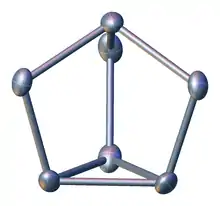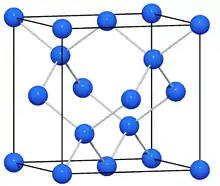Zintl phase
In chemistry, a Zintl phase is the product of a reaction between a group 1 (alkali metal) or group 2 (alkaline earth) and any post-transition metal or metalloid (i.e. from group 13, 14, 15 or 16). It is named after the German chemist Eduard Zintl who investigated them in the 1930s,[1] with the term "Zintl Phases" first used by Laves in 1941.[2]
Zintl phases are a subgroup of brittle, high-melting intermetallic compounds which are diamagnetic or exhibit temperature-independent paramagnetism, and are poor conductors or semiconductors.[3] Zintl noted that there was an atomic volume contraction when these compounds were formed and realised this could indicate cation formation.[3] He suggested that the structures of Zintl phases were ionic, where there was complete electron transfer from the more electropositive metal.[3] The structure of the anion (nowadays called the Zintl ion) should then be considered on the basis of the resulting electronic state. These ideas were further developed to become the Zintl rule or Zintl Klemm concept, where the polyanion structure should be similar to an isoelectronic element.[1]
Polyanions
Zintl phases are polyanionic compounds. Their structure can be understood by a formal electron transfer from the electropositive metal to the more electronegative element. Thus, the valence-electron concentration (VEC) of the element is increased and it formally moves to the right in the periodic system of elements. Generally, the formed anion does not reach an electron-octet. To compensate the lack of electrons, element-element bonds are formed. The structure can be explained by the 8-N rule (replacing the number of valence electrons N by VEC) and is thus similar to an iso-valence electronic element.[4] The formed polyanions can be chains (one-dimensional), two- or three-dimensional networks or molecule-like entities (i.e. Si44--tetrahedra in KSi).
Zintl ions
Zintl phases that contain molecule-like polyanions are often soluble in liquid-ammonia, ethylenediamine, crown ethers or cryptand solutions. Therefore, they are referred to as (naked) Zintl ions. While extended networks are typical for electron rich anions, the isolated species are often found on the more electron poor side. The structures do not resemble pseudo-elemental configurations but can be described as clusters by Wade's rules.
Examples


• NaTl consists of a polyanion (—Tl−—)n with a covalent diamond structure. Na+ ions are located between the anions. Concept: Tl− ~ C.[1]
• NaSi: the polyanion is tetrahedral (Si4)4−, similar to P4. Concept: Si− ~ P.[1]
• Na2Tl: the polyanion is tetrahedral (Tl4)8−, similar to P4. Concept: Tl2- ~ P.[6]
• Cs2NaAs7: the trianion adopts the structure of P4S3. Concept: As− ~ S.
• K12Si17: there are two types of Zintl ions: 2x Si44- (pseudo P4, or according to Wade's rules, 12 = 2n + 4 skeletal-electrons corresponding to a nido-form of a trigonal-bipyramid) and 1x Si94- (according to Wade's rules, 22 = 2n + 4 skeletal-electrons corresponding to a nido-form of a bicapped square-antiprims)
Zintl line
The Zintl line is a hypothetical boundary drawn between group 13 and group 14, to highlight the tendency for group 13 metals to form phases with a variety of stoichiometries, which contrasts to group 14 and above that tend to form salts with polymeric anions. It is now recognised that some Zintl phases contain Zintl clusters and that this accounts for the variable stoichiometries. The bonding in many of these clusters cannot be accounted for by classical octet rule involving covalent, 2-centre, 2-electron bonds, as implied by the Zintl rule. The reaction of Ge, Sn or Pb and Na in liquid NH3 in the presence of ethylene diamine (en) gives the Zintl cluster Na4en7Sn9.[7]
Hydrides
Zintl phases can incorporate hydrogen. Such Zintl phase hydrides[8] can be either formed by direct synthesis of the elements or element hydrides in a hydrogen atmosphere or by a hydrogenation reaction of a pristine Zintl phase. Since Hydrogen has a comparable electronegativity as the post-transition metal it is incorporated as part of the polyanionic patial structure. There are two structural motifs present. A monoatomic hydride can be formed occupying an interstitial site that is coordinated by cations exclusively (Interstitial hydride). Furthermore, hydrogen can bind covalently to the polyanion (polyanionic hydride).
Exceptions
There are examples of a new class of compounds that, on the basis of their chemical formulae, would appear to be Zintl phases, e.g., K8In11,[9] which is metallic and paramagnetic. Molecular orbital calculations have shown that the anion is (In11)7− and that the extra electron is distributed over the cations and, possibly, the anion antibonding orbitals.[9]
References
- S.M. Kauzlarich, Encyclopedia of Inorganic chemistry, 1994, John Wiley & Sons, ISBN 0-471-93620-0
- Fässler, Thomas F. (2011). Zintl Phases: Principles and Recent Developments. Structure and Bonding (Berlin). Structure and Bonding. 139. doi:10.1007/978-3-642-21150-8. ISBN 978-3-642-21149-2. ISSN 0081-5993.
- Sevov, S.C., Zintl Phases in Intermetallic Compounds, Principles and Practice: Progress, Westbrook, J.H.; *Freisher, R.L.: Eds.; John Wiley & Sons. Ltd., Chichester, England, 2002, pp. 113-132 Slavi Chapter
- Schäfer, Herbert; Eisenmann, Brigitte; Müller, Wiking (1973). "Zintl Phases: Transitions between Metallic and Ionic Bonding". Angewandte Chemie International Edition in English. 12 (9): 694–712. doi:10.1002/anie.197306941. ISSN 1521-3773.
- He H, Tyson C, Bobev S (2011). "New compounds with (As7)3- Clusters: Synthesis and Crystal Structures of the Zintl Phases Cs2NaAs7, Cs4ZnAs14 and Cs4CdAs14". Crystals. 1 (3): 87–p98. doi:10.3390/cryst1030087.
- Cotton, F. Albert; Wilkinson, Geoffrey; Murillo, Carlos A.; Bochmann, Manfred (1999), Advanced Inorganic Chemistry (6th ed.), New York: Wiley-Interscience, ISBN 0-471-19957-5
- Greenwood, Norman N.; Earnshaw, Alan (1997). Chemistry of the Elements (2nd ed.). Butterworth-Heinemann. ISBN 978-0-08-037941-8.
- Häussermann U, Kranak VF, Puhakainen K (2010). "Hydrogenous Zintl Phases: Interstitial Versus Polyanionic Hydrides". Zintl Phases. Structure and Bonding. 139. pp. 143–161. doi:10.1007/430_2010_20. ISBN 978-3-642-21149-2. ISSN 0081-5993.
- Slavi C. Sevov; John D. Corbett (1991). "A remarkable hypoelectronic indium cluster in K8In11". Inorg. Chem. 30 (26): 4875–4877. doi:10.1021/ic00026a004.